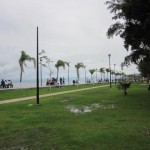The Rainy Season in Ajijic
For many lakeside residents the four month “Rainy Season,” mid-June through mid-October, is their favorite time of year. With a semi-tropical climate supporting a year-long growing season, the lakeside flora is always abundant with an unparalleled variety of plant life. But as we move through our eight months of almost no rain, the hills and mountains become dry with more and more dramatic rock exposed, a beautiful sight in its own right.
The hills are largely exposed rock without enough organic matter created over the centuries to produce a thick soil layer. As a result, once the rainy season ends, the transformation takes place in a few short weeks and autumn colors dominates. However, the soil level is sufficient to support an explosion of plant life once the rains begin. And, within days of the first rains the growth takes hold and the mountains come to life in a matter of days. Even waterfalls appear as the landscape is transformed.
Daily Sunshine, blue skies & comfortable temperatures
The rest of the year has its own abundant charm and beauty. The daily sunshine, blue skies, low humidity, and comfortable temperatures that characterize life from October through May make consulting weather reports a useless activity. What kind of day will it be? The answer is almost always the same…the day will be perfect. With this level of predictability, residents know that any planned outings are virtually guaranteed.
- Kids Happy to see rain in Ajijic
But then early in June each year the rainy season arrives as though it was keeping an appointment. After months of virtually no rain things change quickly and predicting weather becomes a little more of a mystery. The rains are essentially nighttime affairs. Many a night residents awaken to thunderous explosions as lightning storms are frequent. Spectacular lightning bolts light up towering thunderclouds revealing the power of the lakeside storms. If there is rain during the day it usually arrives late in the afternoon. And while the label “rainy season” conjures up images of tropical downpours on cloudy days, it is actually a rarity to have a rainy day. This past rainy season (2012) actually had only two days that would merit the description of a rainy day where outdoor plans would be in jeopardy …two days over four months.
- Water flowing down Ajijic Streets
Spectacular clouds
But no matter what time the rains come, the crystal blue clear skies that predominate the days preceding the rainy season are replaced by hourly displays of ever-changing spectacular clouds. At the lakeside altitude of 5,000 feet sometimes the clouds move across the sky at high speed often unraveling and reforming before your eyes. It is as though one is witnessing a time lapse view of clouds that can feel close enough to touch. Other hours are more placid, but the clouds adorn the sky and provide a canvass for sunlight to play upon from dawn to dusk.
While the rainy season is a summer season there is only a moderate increase in temperature. The winters’s mid to high 70’s F, with evenings rarely dropping to lower than 50 F, begin to see temperatures rise in April. May and June are the warmest months. We have daytime temperatures in the mid to low 80’s F with evenings low temperatures always above 50 F. With June passing, the remainder of the summer temperatures return to the high 70’s. But what is so special about our climate is that throughout the year we only have moderate humidity. And, for the summer months of the rainy season comfort continues to be a constant and it is rare to break a sweat.
North Americans used to living and working in air conditioned interiors are often surprised to learn that there is no need for air conditioning since the lake breezes aided by ceiling fans make both waking and sleeping hours pleasurable and comfortable.
By, Steven Seligman












 /
/  Aviso: Nuestro sitio web se puede leer en inglés y español y la moneda también puede ser en pesos MXN o dólares USD. Desplácese hasta la parte superior de nuestro sitio web para seleccionar su idioma y moneda. Our website can be read in English & Spanish and the currency can also be in MXN pesos or USD dollars. Please scroll to the top of our website to select your language & currency .
Aviso: Nuestro sitio web se puede leer en inglés y español y la moneda también puede ser en pesos MXN o dólares USD. Desplácese hasta la parte superior de nuestro sitio web para seleccionar su idioma y moneda. Our website can be read in English & Spanish and the currency can also be in MXN pesos or USD dollars. Please scroll to the top of our website to select your language & currency . 